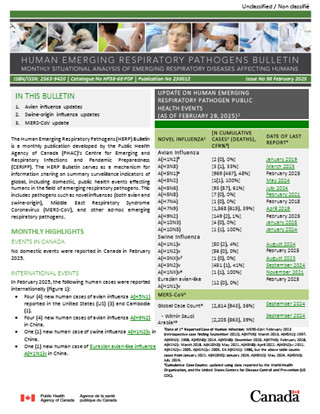Human emerging respiratory pathogens bulletin: Issue 98, February 2025
Download in PDF format
(610 KB, 5 pages)
Organization: Public Health Agency of Canada
Date published: 2025-03-19
Cat.: HP38-6E-PDF
ISBN: 2563-9420
Pub.: 230012
Monthly situational analysis of emerging respiratory diseases affecting humans (data to February 28, 2025).
In this bulletin
- Avian influenza updates
- Swine influenza updates
- Middle East respiratory syndrome coronavirus (MERS-CoV) update
| Novel influenzaFootnote 1 | Cumulative Case CountFootnote 2 | Deaths | Case Fatality Rate %Footnote 3 | Date of Last ReportFootnote 4 |
|---|---|---|---|---|
| Avian Influenza | ||||
| A(H1N2)Footnote 5 | 2 | 0 | 0% | January 2019 |
| A(H3N8) | 3 | 1 | 33% | March 2023 |
| A(H5N1)Footnote 6 | 969 | 467 | 48% | February 2025 |
| A(H5N2) | 1 | 1 | 100% | May 2024 |
| A(H5N6) | 93 | 57 | 61% | July 2024 |
| A(H5N8) | 7 | 0 | 0% | February 2021 |
| A(H7N4) | 1 | 0 | 0% | February 2018 |
| A(H7N9) | 1,568 | 615 | 39% | April 2019 |
| A(H9N2) | 149 | 2 | 1% | February 2025 |
| A(H10N3) | 4 | 0 | 0% | January 2025 |
| A(H10N5) | 1 | 1 | 100% | January 2024 |
| Swine Influenza | ||||
| A(H1N1)v | 50 | 2 | 4% | August 2024 |
| A(H1N2)v | 56 | 0 | 0% | February 2025 |
| A(H3NX)vFootnote 7 | 1 | 0 | 0% | August 2023 |
| A(H3N2)v | 451 | 1 | <1% | September 2024 |
| A(H1NX)vFootnote 8 | 1 | 1 | 100% | November 2021 |
| Eurasian avian-like A(H1N1)v | 12 | 0 | 0% | February 2025 |
| MERS-CoVFootnote 1 | ||||
| Global Case CountFootnote 9 | 2,614 | 943 | 36% | September 2024 |
| - Within Saudi ArabiaFootnote 10 | 2,205 | 863 | 39% | September 2024 |
|
||||
The Human Emerging Respiratory Pathogens (HERP) Bulletin is a monthly publication developed by the Public Health Agency of Canada (PHAC)'s Centre for Emerging and Respiratory Infections and Pandemic Preparedness (CERIPP). The HERP Bulletin serves as a mechanism for information sharing on summary surveillance indicators of global, including domestic, public health events affecting humans in the field of emerging respiratory pathogens. This includes pathogens such as novel influenzas (both avian and swine-origin), Middle East Respiratory Syndrome Coronavirus (MERS-CoV), and other ad-hoc emerging respiratory pathogens.
Monthly Highlights
Events in Canada
No domestic events were reported in Canada in February 2025.
International Events
In February 2025, the following human cases were reported internationally (Figure 1):
- Four (4) new human cases of avian influenza A(H5N1) were reported in the United States (US) (3) and Cambodia (1)
- Four (4) new human cases of avian influenza A(H9N2) were reported in China
- One (1) new human case of swine influenza A(H1N2)v in the US
- One (1) new human case of Eurasian avian-like influenza A(H1N1)v in China
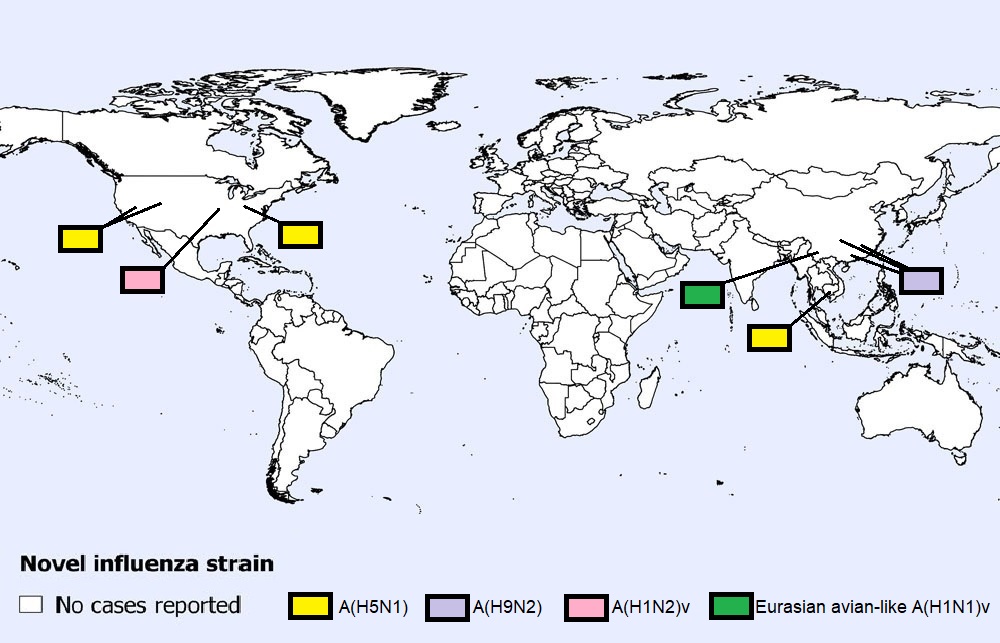
Figure 1 : Descriptive text
- Four (4) A(H5N1) cases were reported in the United States (3) and Cambodia (1).
- Four (4) A(H9N2) cases were reported in China.
- One (1) A(H1N2)v case was reported in the United States.
- One (1) Eurasian avian-like influenza A(H1N1)v case was reported in China.
Note: Map was prepared by CERIPP using data from the latest WHO Event Information Site (EIS) postings. This map reflects data available through these publications as of February 28, 2025.
Avian influenza updates
Avian influenza A(H5N1)
In February 2025, a total of four new human cases of avian influenza A(H5N1) were reported. Three (3) cases were reported in the US and one (1) case was reported in Cambodia.
The first case was a >18-year-old commercial dairy farm worker in Nevada. The case developed conjunctivitis on January 30, 2025. The case was not hospitalized, was not provided with oseltamivir, and has since recovered. As of the time of reporting, contact tracing is ongoing but there is currently no evidence of person-to-person transmission associated with this case. The case was working on a farm where avian influenza A(H5N1) virus had been detected in dairy cattle. This case may represent the first human infection with genotype D1.1 transmitted from dairy cattle to humans.
The second case was a >18-year-old farmworker in Ohio. The case experienced both respiratory and non-respiratory symptoms, was hospitalized, and was later reported to be recovering at home. The case was involved in depopulation activities and had contact with deceased commercial poultry infected with A(H5N1). No secondary cases have been identified. This is the first reported human case of avian influenza A(H5N1) in Ohio. The clade and genotype of this virus is unknown as of the time of reporting.
The third case was a >18-year-old in Wyoming. The case experienced altered mental status, weakness, dehydration, fever, chills, and cough. This case was hospitalized but improved and was discharged on February 8, 2025. The case was then re-admitted to the hospital with pneumonia, but they have since recovered. The case had contact with deceased backyard poultry infected with avian influenza A(H5) prior to illness onset. No secondary cases have been identified. The virus belonged to clade 2.3.4.4b genotype D1.1.
The fourth case was a 2-year-old male from Prey Veng province in Southern Cambodia. The case developed symptoms of cough, fever, and fatigue on February 17, 2025. The case was provided with medication at a clinic, but he was subsequently transferred to a hospital in a nearby municipality on February 20. He developed shortness of breath and was transferred to a national hospital on February 24, where he was placed in isolation and provided with antivirals. The case passed away on February 25. Prior to illness onset, 15 backyard chickens died, and other backyard chickens at the case's house were sick. The case had frequently slept and played near the family's chicken coop prior to illness onset. During the investigation, 69 close contacts were identified. A total of 32 samples were collected from close contacts and symptomatic individuals, all of which tested negative for H5N1. No secondary cases were reported, and no human-to-human transmission was identified. The virus belonged to clade 2.3.2.1c, which is similar to strains circulating among poultry in Cambodia.
Since 2022, 107 human cases of avian influenza A(H5N1), or A(H5) presumed to be A(H5N1), have been reported worldwide (2022: n=6, 2023: n=13, 2024: n=81, 2025: n=7) (Figure 2). There are eleven (11) known fatalities among cases reported in this time period (Figure 3), from Cambodia (8), China (1), the US (1), and Vietnam (1).
In Canada, A(H5N1) detections associated with the current A(H5N1) clade 2.3.4.4b epizootic have been reported in domestic, backyard, and wild bird populations, as well as other animal species. Highly pathogenic avian influenza A(H5N1) has not been detected in Canada in dairy cattle, other livestock, or in raw milk at the time of publication. One (1) domestically acquired human A(H5N1) infection was reported in November 2024 in a Canadian resident with no identified exposure source and one travel-associated human A(H5N1) infection was reported in a Canadian resident returning from travel in China in 2014.
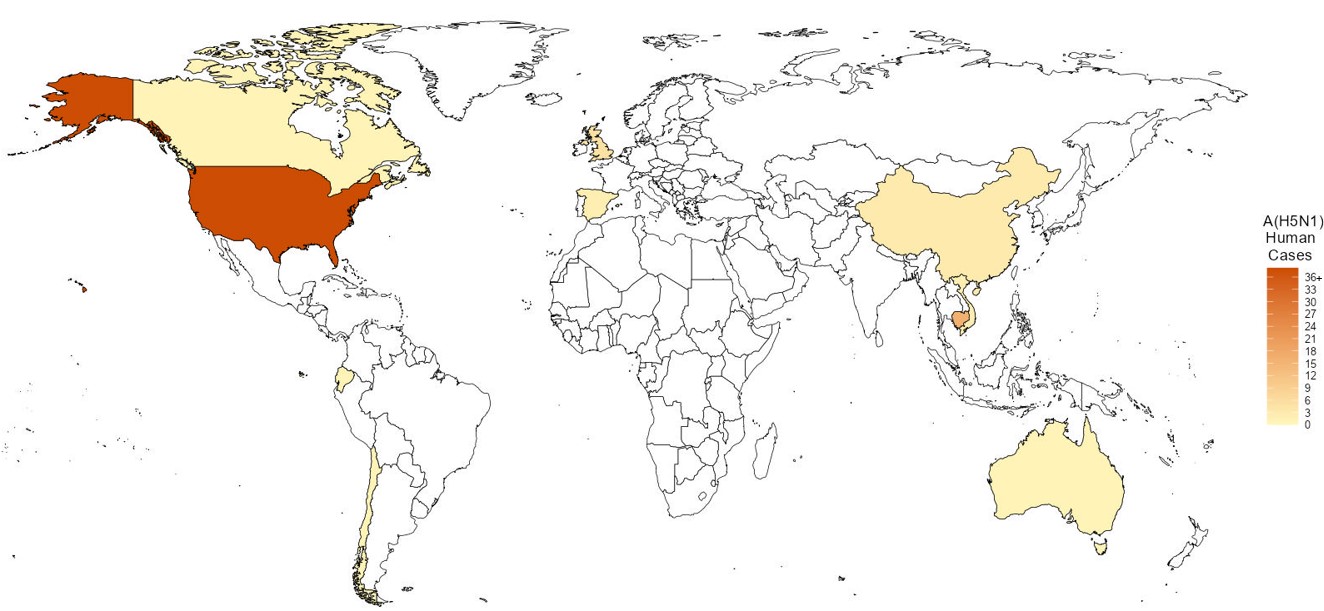
Figure 2 : Descriptive text
- One (1) case was reported out of Australia.
- One (1) case was reported out of Canada
- Eighteen (18) cases were reported out of Cambodia.
- One (1) case was reported out of Chile.
- Three (3) cases were reported out of China.
- One (1) case was reported out of Ecuador.
- Two (2) cases were reported out of Spain.
- Six (6) cases were reported out of the United Kingdom.
- Seventy-one (71) cases were reported out of the United States of America.
- Three (3) cases were reported out of Vietnam.
Note: Map was prepared by CERIPP using data from the WHO EIS postings, the US CDC's Health Alert Network (HAN), and WHO cumulative case counts. This map reflects data available as of February 28, 2025. A(H5) cases reported in the US that are presumed to be A(H5N1) were also included.
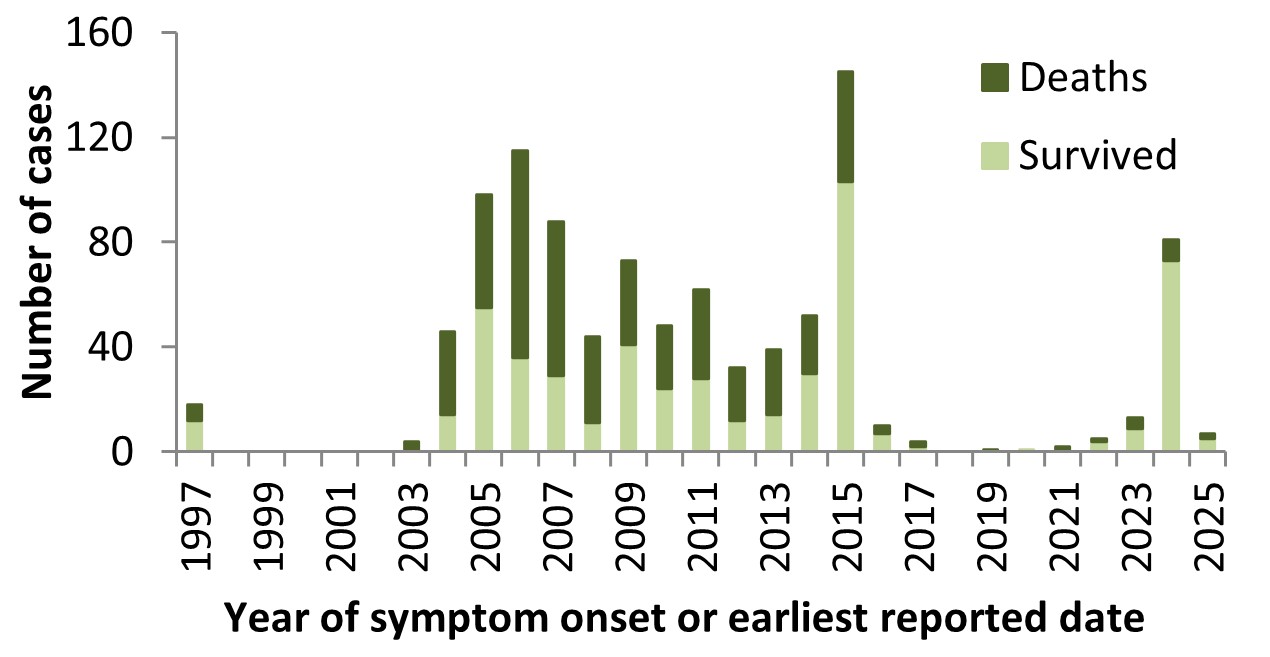
Figure 3 : Descriptive text
| Number of Cases | Deaths | Survived | |
|---|---|---|---|
| 1997 | 18 | 6 | 12 |
| 1998 | 0 | 0 | 0 |
| 1999 | 0 | 0 | 0 |
| 2000 | 0 | 0 | 0 |
| 2001 | 0 | 0 | 0 |
| 2002 | 0 | 0 | 0 |
| 2003 | 4 | 4 | 0 |
| 2004 | 46 | 32 | 14 |
| 2005 | 98 | 43 | 55 |
| 2006 | 115 | 79 | 36 |
| 2007 | 88 | 59 | 29 |
| 2008 | 44 | 33 | 11 |
| 2009 | 73 | 32 | 41 |
| 2010 | 48 | 24 | 24 |
| 2011 | 62 | 34 | 28 |
| 2012 | 32 | 20 | 12 |
| 2013 | 39 | 25 | 14 |
| 2014 | 52 | 22 | 30 |
| 2015 | 145 | 42 | 103 |
| 2016 | 10 | 3 | 7 |
| 2017 | 4 | 2 | 2 |
| 2018 | 0 | 0 | 0 |
| 2019 | 1 | 1 | 0 |
| 2020 | 1 | 0 | 1 |
| 2021 | 2 | 1 | 1 |
| 2022 | 5 | 1 | 4 |
| 2023 | 13 | 4 | 9 |
| 2024 | 81 | 8 | 73 |
| 2025 | 7 | 2 | 5 |
Note: Graph was prepared by CERIPP using data from the WHO EIS postings, the US CDC's Health Alert Network (HAN), and WHO cumulative case counts. This graph reflects data available as of February 28, 2025. A(H5) cases reported in the US that are presumed to be A(H5N1) were also included.
Avian influenza A(H5N2)
The most recent human case of avian influenza A(H5N2) was reported in May 2024 from Mexico.
This was the first ever detected human case of A(H5N2). Since only one human case of A(H5N2) has been reported to date and the availability of clinical information is limited, the full spectrum of disease is unknown.
Avian influenza A(H5N6)
The most recent human case of avian influenza A(H5N6) was reported in July 2024 from China.
Since January 2021, 67 cases of avian influenza A(H5N6) have been reported globally (2021: n=32, 2022: n=25, 2023: n=5, 2024: n=4) (Figure 4); all but one case (2021, Lao PDR) were reported in China. Since the emergence of this virus in 2014, a total of 93 laboratory-confirmed human cases of avian influenza A(H5N6), including at least 57 deaths, have been reported globally (CFR: 61%). No cases have been reported in Canada.
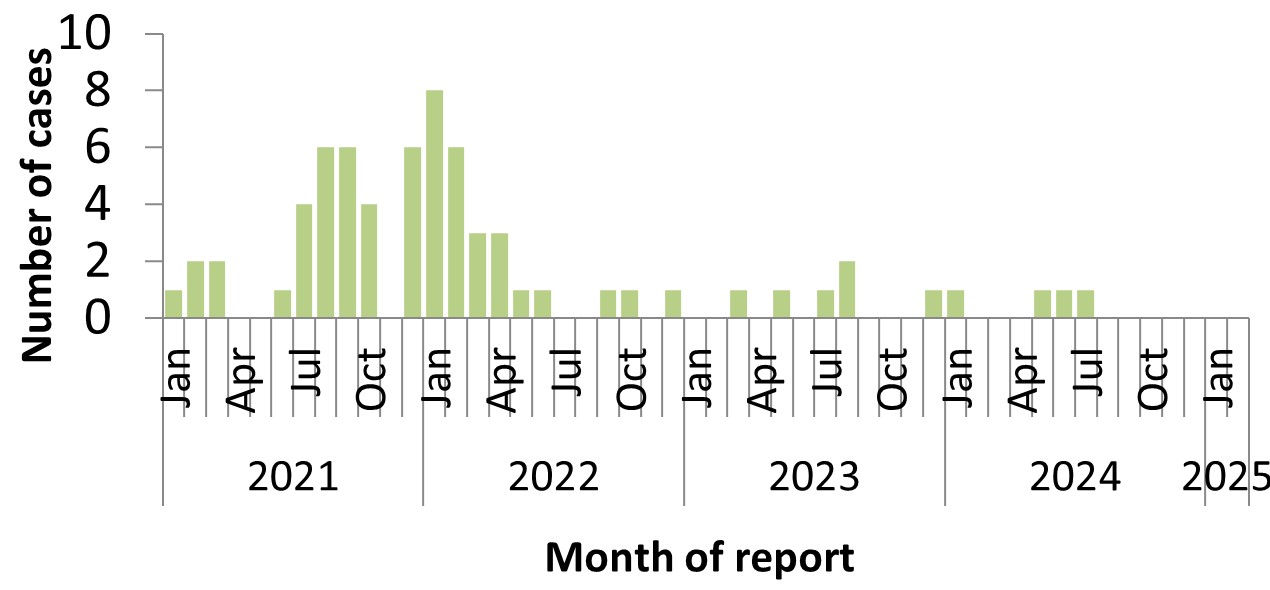
Figure 4 : Descriptive text
| Month | Cases | |
|---|---|---|
| 2021 | Jan | 1 |
| Feb | 2 | |
| Mar | 2 | |
| Apr | 0 | |
| May | 0 | |
| June | 1 | |
| July | 4 | |
| Aug | 6 | |
| Sep | 6 | |
| Oct | 4 | |
| Nov | 0 | |
| Dec | 6 | |
| 2022 | Jan | 8 |
| Feb | 6 | |
| Mar | 3 | |
| Apr | 3 | |
| May | 1 | |
| June | 1 | |
| July | 0 | |
| August | 0 | |
| Sep | 1 | |
| Oct | 1 | |
| Nov | 0 | |
| Dec | 1 | |
| 2023 | Jan | 0 |
| Feb | 0 | |
| Mar | 1 | |
| Apr | 0 | |
| May | 1 | |
| June | 0 | |
| July | 1 | |
| August | 2 | |
| Sep | 0 | |
| Oct | 0 | |
| Nov | 0 | |
| Dec | 1 | |
| 2024 | Jan | 1 |
| Feb | 0 | |
| Mar | 0 | |
| Apr | 0 | |
| May | 1 | |
| June | 1 | |
| July | 1 | |
| August | 0 | |
| Sep | 0 | |
| Oct | 0 | |
| Nov | 0 | |
| Dec | 0 | |
| 2025 | Jan | 0 |
| Feb | 0 |
Note: Graph was prepared by CERIPP using data from the WHO EIS postings and the Hong Kong Centre for Health Protection (CHP) press releases. This graph reflects data available as of February 28, 2025.
Avian influenza A(H9N2)
Four new human cases of avian influenza A(H9N2) were reported in February 2025 in China. There is no known epidemiological link between any of the four cases and no human-to-human transmission associated with any of these four human cases was reported.
The first case was a 2-year-old male who developed illness on December 27, 2024. The second case was a 15-year-old male who developed illness on January 8, 2025. Both cases were from Hunan province. Illness severity, case outcomes, and possible exposure sources were not available at the time of reporting.
The third case was a 72-year-old female from Sichuan province who developed illness on December 27, 2024. The case had underlying conditions, was hospitalized with pneumonia, and recovered from illness. She had exposure to backyard poultry prior to illness onset. Environmental samples and all close contacts were negative for A(H9N2).
The fourth case was a 56-year-old female from Guangdong province who developed mild symptoms on January 20, 2025. She had exposure to a live poultry market prior to symptom onset. Positive H9 samples were found at the live poultry market she had visited. All close contacts were negative for A(H9N2).
Six human cases of avian influenza A(H9N2) have been reported so far in 2025, all from China. In 2024, 21 human cases of avian influenza A(H9N2) were reported worldwide, from China (18), India (1), Vietnam (1), and Ghana (1). Since the emergence of avian influenza A(H9N2) in the human population in 1998, 149 cases have been reported worldwide, with a CFR of approximately 1%. No cases have been reported in Canada at the time of publication.
Avian influenza A(H10N3)
The most recent human case of avian influenza A(H10N3) was reported in January 2025 from China.
Since the emergence of this virus in the human population in 2021, 4 cases have been reported, all from China (May 2021: n=1, August 2022: n=1, April 2024: n=1; January 2025: n=1). The CFR is 0%; however, all human cases of A(H10N3) that have been detected to date experienced severe illness. With only 4 human cases to date, the full spectrum of disease is highly uncertain.
Swine influenza updates
Swine origin influenza A(H1N1)v
The most recent human cases of swine origin influenza A(H1N1)v were reported in August 2024 from the US (1) and Vietnam (1).
A total of 50 human cases of A(H1N1)v have been reported globally since 2005, with a 4% CFR. Two A(H1N1)v detections have been reported in Canadian residents since reporting began in 2005, with the first case reported in Ontario in September 2012 and the second case reported in Manitoba in April 2021 (see HERP Bulletin no 52).
Swine origin influenza A(H1N2)v
One new human case of swine origin influenza A(H1N2)v was reported in February 2025 from the US.
The case was an 18-year-old individual in Iowa who developed symptoms on January 17, 2025. The case had underlying medical conditions and was hospitalized on January 18, 2025 with symptoms of cough and abdominal pain. The case received antiviral treatment, was discharged, and has since recovered. No direct or indirect swine contact was identified. No illness was detected among close contacts and no human-to-human transmission associated with this case was identified.
A total of 56 human cases of swine origin influenza A(H1N2)v have been reported globally since 2005, with a 0% CFR. Three swine origin influenza A(H1N2)v detections have been reported in Canadian residents since reporting began in 2005. The first case was reported in Alberta in October 2020 (see HERP Bulletin no 46), the second case was reported in Manitoba in April 2021 (see HERP Bulletin no 52) and the latest case in Canada was reported in November 2021 in Manitoba (see HERP Bulletin no 59).
Swine origin influenza A(H3N2/H3NX)v
The most recent human cases of swine origin influenza A(H3N2)v were reported in September 2024 from the US.
Globally, 451 swine origin influenza A(H3N2)v cases have been reported since 2005, with <1% CFR. Four human cases of swine origin influenza A(H3N2)v have been reported in Canada since 2005. The first case of A(H3N2)v in Canada was reported in Ontario in 2005. This was followed by a second case in Ontario in 2016, a third case in Manitoba in June 2021 (see HERP Bulletin no 54), and a fourth case in Saskatchewan in July 2024 (see HERP Bulletin no 91).
Eurasian avian-like influenza A(H1N1)v
One new human case of Eurasian avian-like influenza A(H1N1)v was reported in February 2025 from China.
The case was a 1-year-old female from Yunnan province. She developed upper respiratory tract symptoms on November 12, 2024. She was not hospitalized. Prior to illness onset, the case had frequent exposure to backyard pigs. Samples from the pigsty, pig, and all close contacts were negative for the virus. There was no evidence of human-to-human transmission.
This is the first human case of Eurasian avian-like influenza A(H1N1)v reported worldwide in 2025, and the first since 2023. A total of 12 human cases of Eurasian avian-like influenza A(H1N1)v have been reported globally since January 2021 with a 0% CFR.
Middle East respiratory syndrome coronavirus (MERS-CoV) update
The most recent human case of MERS-CoV was reported in September 2024 from the Kingdom of Saudi Arabia.
According to the WHO, 2,614 laboratory-confirmed cases of MERS-CoV, including 943 deaths, have been reported globally since reporting began in 2012 (CFR: 36%) (Figure 5). No cases have ever been reported in Canada.
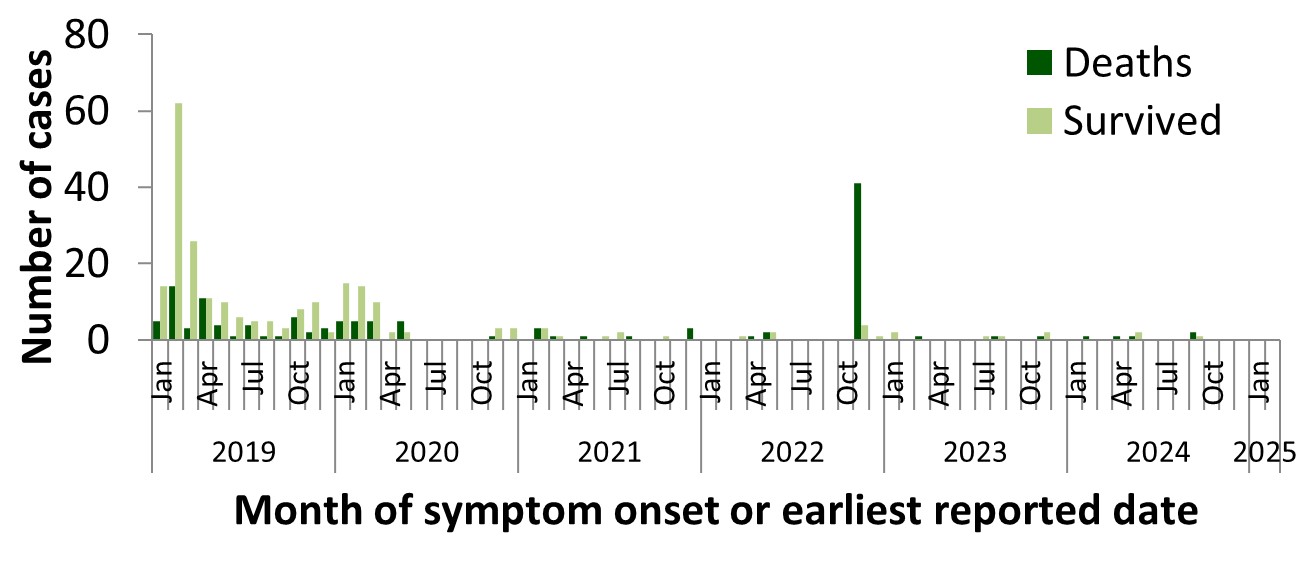
Figure 5 : Descriptive text
| Deaths | Survived | ||
|---|---|---|---|
| 2019 | Jan | 5 | 14 |
| Feb | 14 | 62 | |
| Mar | 3 | 26 | |
| Apr | 11 | 11 | |
| May | 4 | 10 | |
| June | 1 | 6 | |
| July | 4 | 5 | |
| Aug | 1 | 5 | |
| Sep | 1 | 3 | |
| Oct | 6 | 8 | |
| Nov | 2 | 10 | |
| Dec | 3 | 2 | |
| 2020 | Jan | 5 | 15 |
| Feb | 5 | 14 | |
| Mar | 5 | 10 | |
| Apr | 0 | 2 | |
| May | 5 | 2 | |
| June | 0 | 0 | |
| July | 0 | 0 | |
| Aug | 0 | 0 | |
| Sep | 0 | 0 | |
| Oct | 0 | 0 | |
| Nov | 1 | 3 | |
| Dec | 0 | 3 | |
| 2021 | Jan | 0 | 0 |
| Feb | 3 | 3 | |
| Mar | 1 | 1 | |
| Apr | 0 | 0 | |
| May | 1 | 0 | |
| June | 0 | 1 | |
| July | 0 | 2 | |
| Aug | 1 | 0 | |
| Sep | 0 | 0 | |
| Oct | 0 | 1 | |
| Nov | 0 | 0 | |
| Dec | 3 | 0 | |
| 2022 | Jan | 0 | 0 |
| Feb | 0 | 0 | |
| Mar | 0 | 1 | |
| Apr | 1 | 0 | |
| May | 2 | 2 | |
| June | 0 | 0 | |
| July | 0 | 0 | |
| Aug | 0 | 0 | |
| Sep | 0 | 0 | |
| Oct | 0 | 0 | |
| Nov | 41 | 4 | |
| Dec | 0 | 1 | |
| 2023 | Jan | 0 | 2 |
| Feb | 0 | 0 | |
| Mar | 1 | 1 | |
| Apr | 0 | 0 | |
| May | 0 | 0 | |
| June | 0 | 0 | |
| July | 0 | 1 | |
| Aug | 2 | 1 | |
| Sep | 0 | 0 | |
| Oct | 0 | 0 | |
| Nov | 1 | 2 | |
| Dec | 0 | 0 | |
| 2024 | Jan | 0 | 0 |
| Feb | 1 | 0 | |
| Mar | 0 | 0 | |
| Apr | 1 | 0 | |
| May | 1 | 2 | |
| June | 0 | 0 | |
| July | 0 | 0 | |
| Aug | 0 | 0 | |
| Sep | 2 | 1 | |
| Oct | 0 | 0 | |
| Nov | 0 | 0 | |
| Dec | 0 | 0 | |
| 2025 | Jan | 0 | 0 |
| Feb | 0 | 0 | |
Note: Graph was prepared by CERIPP using data from the WHO Disease Outbreak News (DON) and Saudi Arabia's Ministry of Health. This graph reflects data available as of February 28, 2025. The data integrates CERIPP real-time reporting with WHO DON retrospective reporting of MERS-CoV cases and deaths. In November 2022, the WHO published a DON article that updated their counts with retrospective cases and deaths, which resulted in an increase of an additional 5 cases and 41 deaths compared to their previous MERS-CoV-related DON. In August 2023, the WHO published a DON article with case information for three retrospective MERS-CoV cases and two deaths. These three cases and one death were already reflected in the cumulative case count of the DON article published in July 2023, as well as the case totals published in HERP Bulletin no 79. In May 2024, the WHO published a DON article with case information for one single, fatal case of MERS-CoV. This fatal case was already reflected in the case totals published in HERP Bulletin no 88.
